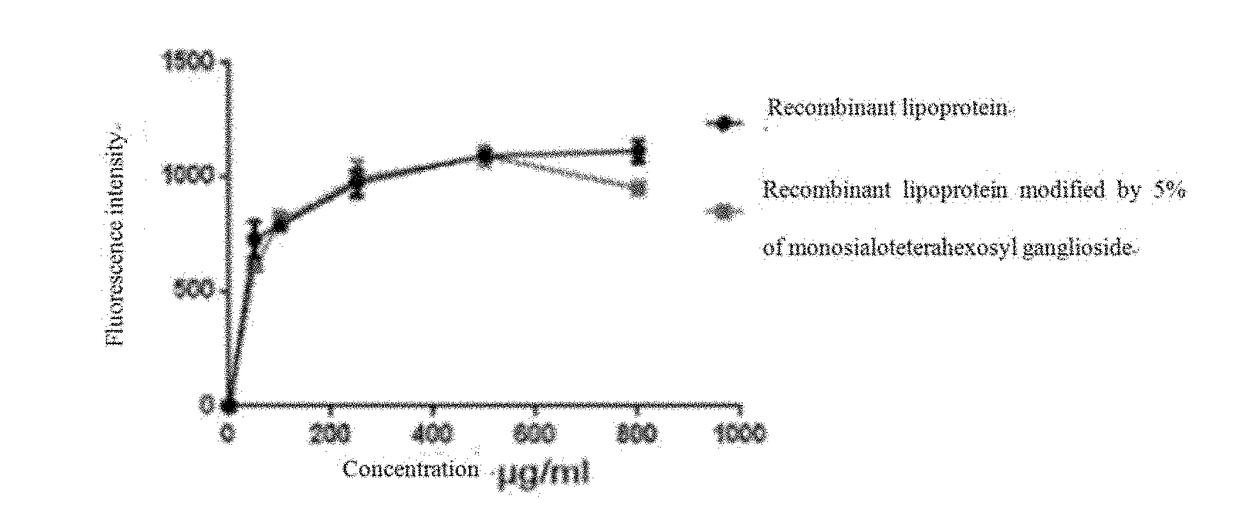Recombinant lipoprotein modified by monosialotetrahexosyl ganglioside and application thereof
a technology of monosialotetrahexosyl ganglioside and lipoprotein, which is applied in the field of neuropharmacology and chemical pharmaceuticals, can solve the problems of improving the decline of learning and memorial functions, severely threatening human health and survival quality, and increasing serious public health problems and economic problems, so as to improve the treatment effect of ad and improve the affinity with a. , the effect of improving the treatment
- Summary
- Abstract
- Description
- Claims
- Application Information
AI Technical Summary
Benefits of technology
Problems solved by technology
Method used
Image
Examples
embodiment 1
ncreasing Monodispersity of a Reconstituted Lipoprotein Through the Modification with Monosialoteterahexosyl Ganglioside
[0046](1) Preparation
[0047]steps: doping monosialoteterahexosyl ganglioside which accounts for 5%, 10% and 20% of a molar ratio of total lipids into dimyristoyl phosphatidylcholine which accounts for 95%, 90% and 80% of the molar ratio of the total lipids, dissolving with chloroform, performing decompression evaporation to remove the organic solvent, hydrating lipid membranes in phosphate buffer at a pH of 7.4, and ultrasonically homogenizing to obtain liposome (the total mass of the lipid of 4 mg) modified by the monosialoteteterahexosyl ganglioside; and adding 0.8 mg of ApoE, slightly mixing to be uniform, and incubating in a orbital shaker at 100 rpm at 37° C. for 36 h, thereby obtaining the reconstituted lipoprotein modified by the monosialoteterahexosyl ganglioside.
[0048](2) Characterization
[0049]Particle sizes and zeta potentials are determined by dynamic las...
embodiment 2
ncreasing Binding Affinity to Aβ with a Reconstituted Lipoprotein Through the Modification with Monosialoteterahexosyl Ganglioside
[0051]Preparation
[0052]steps: doping monosialoteterahexosyl ganglioside which accounts for 5%, 10% and 20% of a molar ratio of total lipids into dipalmitoyl phosphatidyl choline which accounts for 95%, 90% and 80% of the molar ratio of the total lipids (the total mass of the lipid is 4 mg), adding 0.8 mg of ApoE, and preparing a reconstituted lipoprotein modified by the monosialoteterahexosyl ganglioside by using the same method in embodiment 1;
[0053]doping cardiolipin which accounts for 5% of the molar ratio of the total lipids into the dipalmitoyl phosphatidyl choline which accounts for 95% of the molar ratio of the total lipids (the total mass of the lipid is 4 mg), adding 0.8 mg of ApoE, and preparing a reconstituted lipoprotein modified by the cardiolipin according to the above method;
[0054]and doping sulfatide which accounts for 10% of the molar rat...
embodiment 3
ncreasing Microglial Cells-Mediated Uptake and Degradation Following the Treatment with Reconstituted Lipoprotein Modified by Monosialoteterahexosyl Ganglioside
[0058](1) Preparation
[0059]steps: adding monosialoteterahexosyl ganglioside which accounts for 5% of a molar ratio of total lipids into a mixture of phosphatidylcholine and phosphatidic acid accounting for 95% of the molar ratio of the total lipids (the total mass of the lipid is 4 mg), adding 0.4 mg of ApoE, and preparing a reconstituted lipoprotein modified by the monosialoteterahexosyl ganglioside by using the same method in embodiment 1.
[0060](2) Facilitation of a Uptake in Primary Microglial Cells by the Reconstituted Lipoprotein Modified with Monosialoteterahexosyl Ganglioside
[0061]steps: adding FAM fluorescently-labeled Aβ1-42 into 96-well plates cultured with microglial cells, diluting the reconstituted lipoprotein and the reconstituted lipoprotein modified with the monosialoteterahexosyl ganglioside with DMEM and add...
PUM
| Property | Measurement | Unit |
|---|---|---|
| particle size | aaaaa | aaaaa |
| particle size | aaaaa | aaaaa |
| pH | aaaaa | aaaaa |
Abstract
Description
Claims
Application Information
 Login to View More
Login to View More - R&D
- Intellectual Property
- Life Sciences
- Materials
- Tech Scout
- Unparalleled Data Quality
- Higher Quality Content
- 60% Fewer Hallucinations
Browse by: Latest US Patents, China's latest patents, Technical Efficacy Thesaurus, Application Domain, Technology Topic, Popular Technical Reports.
© 2025 PatSnap. All rights reserved.Legal|Privacy policy|Modern Slavery Act Transparency Statement|Sitemap|About US| Contact US: help@patsnap.com



